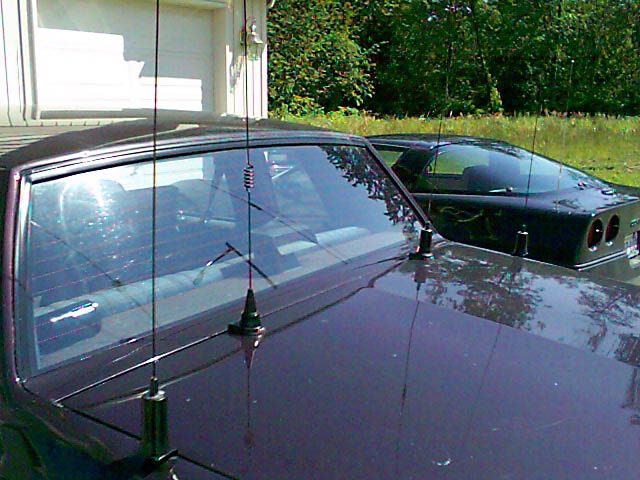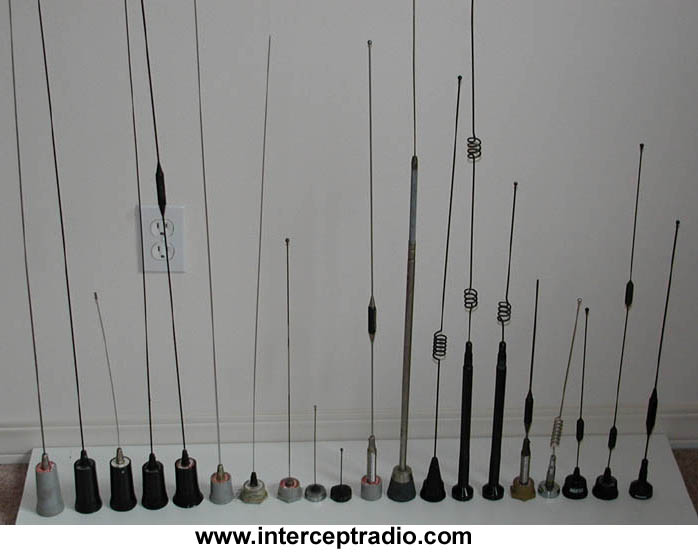Mobile Antenna Comparison
From InterceptRadio.com Wiki
(Difference between revisions)
Rich (Talk | contribs)
(Created page with 'Antenna comparison http://www.interceptradio.com/files/wiki/antennas.jpg 20 antennas were tested to see which ones were the best for receiving. All the antennas are 3/4" Mo…')
Newer edit →
(Created page with 'Antenna comparison http://www.interceptradio.com/files/wiki/antennas.jpg 20 antennas were tested to see which ones were the best for receiving. All the antennas are 3/4" Mo…')
Newer edit →
Revision as of 02:19, 6 January 2010
Antenna comparison
20 antennas were tested to see which ones were the best for receiving.
All the antennas are 3/4" Motorola TAD/TAE mount (aka "NMO").
The following lists are ordered as per what you see in the picture (left to right).
General information:
Manufacturer Model Type Freq rating/gain ------------------- ------------------ ---------------------------------------------- ------------------------- Larsen NMO-27 (new style) 1/4 wave base loaded 27-28/0dB Radiall/Larsen NMO-27B 1/4 wave base loaded 27-28/0dB Larsen NMO-30B 1/4 wave base loaded 30-40/0dB Larsen NMO-50C 1/4 wave base loaded 47-54/0dB Larsen NMO-2/70 (old style) loaded 1/2 (VHF), closed coil collinear (UHF) 144-148/6dB 440-450/3.5dB Larsen NMO-150 (new sytle) 5/8 wave base loaded 144-148/3dB Larsen NMO-Q 1/4 wave 150-170/0dB Larsen NMO-Q 1/4 wave 95-105/0dB Antenna Specialists ASPRD1615 1/4 wave 430-470/0dB Maxrad BMUF9000 1/4 wave 896-940/0dB Larsen NMO-450 5/8 over 1/2 wave closed coil collinear 450-470/3.4dB Motorola TDE6082A (?) closed coil collinear 460-470/5dB Larsen NMO-UHF 5/8 over 1/4 wave open coil collinear 450-470/3.2dB Maxrad BMUF8125 1/2 over 1/2 over 1/4 wave open coil trilinear 806-866/5dB Maxrad BMUF9043 1/2 over 1/4 wave open coil collinear elevated 896-940/3dB Larsen NMO-800 5/8 over 1/2 wave closed coil collinear 806-866/3.4dB Maxrad unknown 5/8 over 1/2 wave open coil collinear 806-866/3.4dB Larsen NMO3E825B 5/8 over 1/4 wave closed coil collinear 825-896/3.2dB Larsen NMO5E825B 5/8 over 5/8 over 1/4 wave closed coil trilinear 825-896/5dB Maxrad BMAXSCAN1000 double 1/2 over 1/4 closed coil collinear (800) VHF/UHF/800
Performance:
Model LW AM SW CB VHF-Lo FM Air VHF-150 VHF-165 VHF-TV 220 MilAir UHF-Lo UHF-Hi UHF-TV 800 900 -------------------- -- -- -- -- ------ -- --- ------- ------- ------ --- ------ ------ ------ ------ --- --- NMO-27 (new style) 2 5 5 7 2 2 - - - 2 1 - 2 - 2 6 4 NMO-27B - 1 4 7 5 4 4 2 3 4 4 1 2 1 5 4 4 NMO-30B - 1 4 7 5 4 2 1 2 4 5 - 2 1 5 1 3 NMO-50C - 1 2 2 7 5 3 7 6 5 3 - 1 - 3 2 4 NMO-2/70 (old sytle) - - 1 - 2 4 3 6 7 6 5 2 8 8 5 3 4 NMO-150 (new sytle) 2 6 5 4 5 5 4 7 5 5 5 - 2 2 1 1 1 NMO-Q (150-170) 1 4 3 2 2 4 5 4 8 6 5 3 5 4 5 4 4 NMO-Q (95-105) 1 5 5 2 4 6 5 3 5 5 2 1 4 2 5 3 5 ASPRD1615 - 2 3 - 1 3 1 1 2 4 2 1 7 6 4 5 5 BMUF9000 - 1 1 - 1 1 - 1 1 3 1 - 1 1 4 7 6 NMO-450 2 5 5 3 4 6 5 2 6 5 2 2 6 5 4 5 6 TDE6082A (?) 2 6 5 3 5 6 4 2 4 5 5 1 5 4 3 2 5 NMO-UHF 2 5 5 2 4 6 4 2 5 5 2 1 6 5 4 5 6 BMUF8125 - 6 5 2 5 6 5 3 5 5 5 1 2 - 4 6 7 BMUF9043 1 7 5 3 2 5 6 5 6 6 5 2 2 1 5 7 7 NMO-800 1 6 5 4 3 5 5 4 8 6 6 3 4 3 6 8 8 Maxrad (800) - 3 2 3 2 5 4 3 6 6 5 1 2 2 5 6 4 NMO3E825B - 5 5 2 1 5 3 2 6 6 5 2 3 2 6 6 4 NMO5E825B 1 6 5 3 3 6 5 3 5 5 2 2 1 1 3 6 4 BMAXSCAN1000 - 3 5 2 2 5 5 4 6 6 5 1 7 6 6 4 5
- = Absolutely no reception 1 = Extremely bad reception, you might barely receive some very strong stations. 2 = Bad reception, strong stations come in very weak but can be heard. 3 = Limited range reception, stations come in about 1/4 - 1/2 the strength compared to an average antenna for this band. 4 = Below average reception, stations come in about 3/4 the strength compared to an average antenna for this band. 5 = Average reception. Stations come in at reasonable levels. 6 = Slightly above average reception, perhaps 1/2 to 1 S-Unit above an average antenna. 7 = Above average reception, perhaps 1 to 1.5 S-Units above an average antenna. 8 = Great reception, perhaps 2 S-Units above an average antenna. 9 = Too good to be true.
All tests were done with an AOR-3000 receiver. Minimum of 5 measurements per band from fixed stations at varying distances and power levels.
Comments:
Yes, I know the NMO-30B has the wrong whip in the picture. I tested it with the correct whip.
The MilAir readings are somewhat pessimistic since all I had were a handful of weak stations to test against. It wouldn't be unreasonable to knock the numbers up a few notches to estimate how it would perform in general operation.
The lower-frequency base-loaded antennas tend to block out VHF/UHF, most likely because of impedance issues where the coax couples to the loading coil. Its interesting to note how the 3rd-generation Larsen NMO-27B has partial VHF reception while the 2nd-generation NMO-27 does not. My guess is that Larsen made an engineering change to accomodate CB radios like the Cobra-29WX which include a VHF weather-band receiver. Another interesting thing to note is the 800mhz reception. While I certainly wouldn't count on a low-band antenna for 800mhz, whats likely happening is the loading coil itself is acting as the receiving antenna given the short wavelength of the signal.
The Larsen dual-bander (NMO-2/70) is totally deaf below VHF. Probably another loading coil impedance issue since it will have a base-load to correctly match the half-wave VHF radiator.
The Larsen NMO-150 works great for VHF, shortwave and AM but chokes on UHF and 800.
The quarter-waves and other antennas lacking a base-load (800mhz collinears, etc) all seem to work great at lower frequencies, since there are no impedance issues with loading coil coupling. Likewise the lower freqs see it as a chunk of wire, minus some miscellaneous impedances when it hits the coils on the antenna rod. The only exceptions to this rule are the UHF and 800/900mhz quarter-waves where the antenna is physically too short to have any receive efficiency on the lower frequencies.
As per the above note, the open-coil Larsen NMO-UHF turned out to be a real winner. While slightly less performing on 800/900 since its not designed for it, this would be a great selection for an "all-band" antenna to connect to a wideband receiver like an AOR or a Yupiteru.
Now for the curve-ball. Look at the Larsen NMO-800. Given its short size I kind of scratched my head at the lower-frequency performance, but the tests don't lie. Nonetheless I probably wouldn't count on it compared to the much longer NMO-UHF for broadband reception, but if very small size was a requirement this would definitely be my second choice for a compact antenna. Notice the performance difference compared to the Maxrad 800 which is of identical size and electrical design, with the only difference being an open coil compared to a closed coil. Even the most minor differences can make a large impact on performance.
So.. my first choice for a compact antenna would be the Maxrad BMAXSCAN1000, since it has much better UHF performance than the NMO-800, and reasonable performance on the other bands.
I had hoped to see the Maxrad elevated 800mhz trilinear be the winner since it had the combination of long physical length, high 800mhz gain, and no base-load, however it ended up being so-so on VHF and pretty crappy on UHF. Still not bad in the overall scheme of things.
The big Motorola 5db UHF did surprisingly well on the lower bands, but the thing is just too darn ugly to put on my car.
The Larsen 3E825 was one of their Nextel OEM's. The 5E825 was on a Larsen "Special" base. The 5E825 was pretty awesome when it came to broadband operation, except it was somewhat deaf on UHF which was sort of a party-pooper.
Now its brand-preference opinion time !!
First, always use NMO mounts. They are THE standard and give you the most options for swapping antennas around on your car. You can also use them for base antennas, just use a mobile L-bracket and screw it onto your mast or whatever. Get some copper rod at the hardware store and attach 3 or 4 ground radials to the mast (unless receiving only 800/900mhz with an antenna designed not to require a ground).
Larsen and Maxrad are the way to go. On some models you can save a few bucks and still retain quality with the Maxrad.
Don't use mag-mounts unless you really have to. I don't care what the manufacturer says, they will scratch your paint. Not to mention they don't ground as good as other mounting arrangements.
Drilling holes in your roof is the best way to go (performance-wise), but personally I don't like turning my cars into Swiss-cheese. Go with L-Brackets on the hood or rear deck, as it takes two minor side-drilled holes that won't be an issue when you sell your car. Edge-mounting antennas like this will give a ground only halfway around the base of the antenna which can make for less-than-optimal radiation patterns, although I certainly haven't noticed any problems worth crying over.
Another great mount is the trunk-lip bracket. The Larsen ones are ugly and expensive. Get the Maxrad. These require no holes and work great. Sometimes you need to do minor antenna re-tuning on lower-frequency antennas since part of the radiated signal will bounce off the metal on the roof of the car. Again, not a perfect radiation pattern but certainly usable.
If you plan on receiving 800/900mhz using an NMO mount, check any cable that you got with your antenna or bracket and see if its standard RG-58. If so, chuck it and get an 800/900mhz NMO mounting kit that has RG-58 double-shield or better cable (Cushcraft Ultralink for example). Despite the loss-per-hundred-feet ratings on RG-58, you can suffer noticeable losses if you use it on short mobile cable runs.
Remember to pick up the twist-on "rain caps" for your antenna mounts and drop them in your glove box. They cost like $1.50 each and come in handy if you need to stash your antennas in the trunk when you park your car downtown, at long-term airport parking, or in one of the less friendly neighborhoods.
Glass mounts suck for a variety of reasons. Single-band receive on 800mhz is about the only worthwhile use for these terrible things. Make sure you don't have aftermarket window tint and make sure your glass doesn't have carbon-impregnated tint. Best way to tell is to look at the glass from an angle under bright sunlight with polarized sunglasses and look for oval "splotches" in the glass. If you have this kind of glass, the best way to get around it is to use a service monitor with on-glass coupling boxes connected to the tracking generator and spectrum analyzer, then hunt across the glass until you find a hot-spot that passes the signal good.
2-19-2003 Rich W7KI


